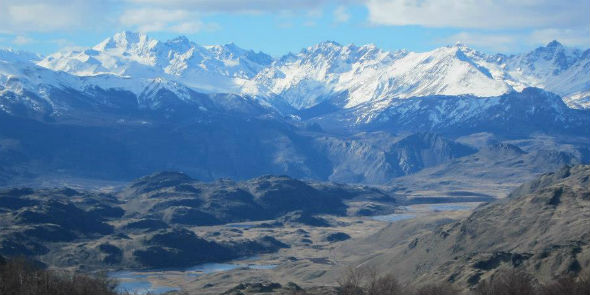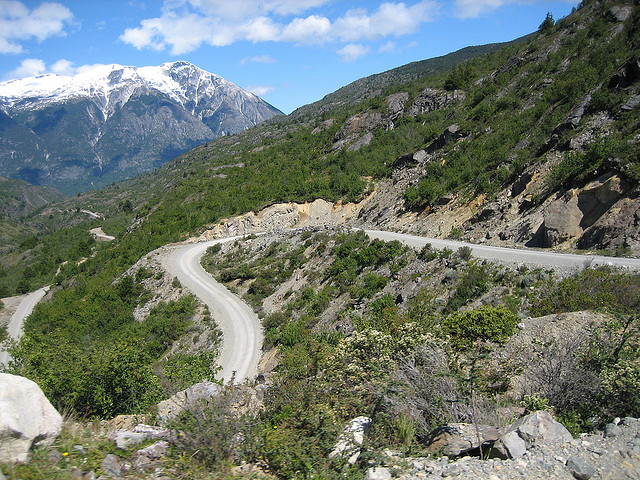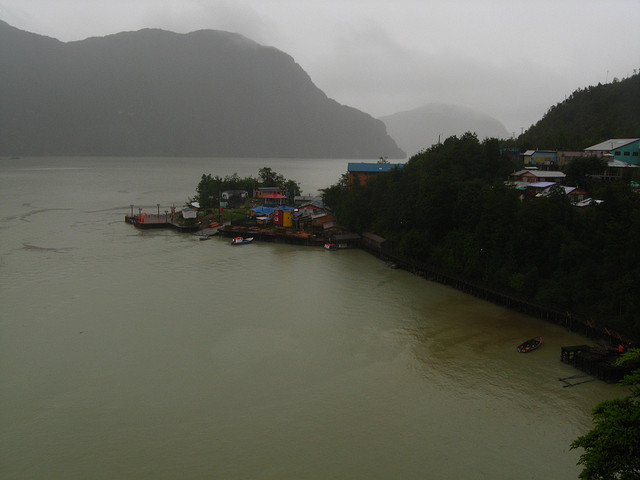Patagonia is notorious for seducing adventurous spirits, and I fell into the trap happily. From glacial fields stretching into Antarctica to National parks, opportunities for adventure abound. Jagged peaks and frothy whitewater beg to be summited, rafted and explored. Vast mountain ranges provide the perfect stage for epic journeys and endless horizons provide the wandering spirit a chance to feel like the only person on earth.

One of the many rewarding views on the Lagunas Altas trail. (Photo: Chelsey Perron)
As a recent college graduate, Patagonia’s remoteness called to me and I responded by taking a job at the future Patagonia National Park. For five months I taught English to the smallest parks habitants; children of local biologists, builders, and cowboys. The park employees kept busy by making sure I knew as much about Chilean culture as their kids did about the English language, with afternoon Cueca lessons (the national dance of Chile), and regular asados (traditional barbeques) at the schoolhouse where I taught. A converted sheep-shearing shed, the school sat at the back of the park’s main facilities, nestled into the valley formed by the ever-impressive Andes.
Lying on the opposite side of the equator, Chile’s seasons are reversed of those in the United States. Therefore, just as my friends back home were gearing up for the winter months, I was preparing for warm-weather activities. November proved to be a beautiful month, and the perfect time to beat the hordes of winter-break tourists that would swarm the National Parks that have put Patagonia, Chile on the map for adventurers around the world. I decided to start internally, working my way through the newly-formed hiking trails and riding horses next to guachos (Patagonia’s iconic cowboys) making it a goal to absorb as much knowledge about the region and its landscapes as possible. Patagonia National Park—my home for those months—lies directly on Chile’s famous Carretera Austral, an extensive highway built by the late dictator Pinochet to connect Northern Chile to its remote southern parts. Whether I was entering from close-by Argentina or coming from further north in Chile, the drive to the park was just the beginning of the beauty that I would find on this stretch of Chile’s famous Route 7. Here are just a few of the stops on my route—ones that would enhance any traveler’s journey:

The Carretera Austral. (Photo: Nick Herber via Flickr)
Trek the Future Patagonia National Park
While the park is stunning at any time of year, spring and summer are especially impressive and conditions are warmer and drier, making travel easier and hikes less strenuous. Being a future National Park, guests have to be independent but in exchange are rewarded with unspoiled scenery and limitless bushes of califate berries; a delicious snack whose legend claims that those who eat it are destined to return. It’s possible to trek for days in the park with only wild llamas, armadillos and if you’re lucky—the endangered huemul deer—for company. The Chilean condor soars overhead, and GPS-collared pumas are elusive proof of wildlife populations that are returning to this once-barren sheep ranch. Lagunas Altas (meaning “High Lakes”), the park’s first official trail is a strenuous but rewarding 26 kilometers of breathtaking scenery. Only recently mapped, the trail works its way up through dense moss-covered forests and eventually to the mountains ridge where the trails namesake becomes apparent. Snow-capped mountains, high alpine lakes, and winding trails left behind by the parks iconic wild llamas provide a show for the long stretch of flat, high-altitude terrain before the steep descent back to the parks headquarters. The trek can be completed in a day for those with limited schedules or can be stretched to a three-day journey where travelers will have a better chance at spotting wildlife, take an icy dip in pristine waters, and explore the parks world-class campsites.
Explore the marble caves of Puerto Tranquillo
Puerto Tranquillo (literally translated to “the tranquil port”) is the last place to stop for gas before the Future Patagonia National Park, and the town lives up to its name. Little more than a sleepy fishing village—albeit one with views of the towering Andes atop turquoise water—is home to a few restaurants serving fresh-caught salmon, friendly people, and perhaps Route 7’s best kept secret. Scattered docks and motorboats dot the lakes shoreline, and tourists can pay fisherman-turned-tour guides to explore the Capilla de Marmol, or “Marble Cathedral.” After a 5 minute speedboat ride, the marble caves appear out of the base of surrounding mountains and their extensive channels can be observed from afar. Boats tether to natural columns created by massive stalactites so tourists can explore cave walls whose minerals drip down, creating mesmerizing gold, black and cream colored shapes while water ripples reflect off of the dimpled rocks surface. Depending on the time of day, the water turns from a dark navy blue to milky turquoise as sunlight reflects on marble particles floating in the water, creating a magical effect that only those exploring this part of the massive lake can experience. The caves can be explored for hours and guides are happy to navigate to new areas before heading back to the main docks and grabbing a cup of creamy hot chocolate and continuing on the road.
Visit the seaside town of Tortel

Caleta Tortel (Photo: Hector Garcia via Flickr)
The tiny town of Caleta Tortel is technically a commune in southern Chile, and its population is almost exclusively employed by the lumber industry. Originally exploited for its valuable cypress wood, the town has grown to be a tourist attraction due to its multiple kilometers of stairways, docks and paths. Built by locals with local wood, the staircases serve as the only mode of transportation between homes and their steep ascents provide impressive vistas of the scenic cove. The town itself is humble, and tourists should pack their own lunch and be ready to dangle their legs over the hand-built docks, soak in the salty air, and revel in the tranquility that this seaside town at the end of the world provides. Architecture buffs will enjoy the construction techniques used to attach the small but colorful homes to the side of the cliffs, and nature lovers will enjoy strolling along the densely-vegetated mountain while observing marine birds and the occasional seal. Tortel feels like traveling back in time and is a refreshing look at Patagonia before tourism, and where Patagonia’s real value—its resources—are still used to sustain a thriving local community.
Above all, Patagonia is a place that people seek on their own terms. It’s a place of mystery, transformational landscapes, and one that the memory gladly clings to. For me, it was a time of transition and exploration that helped kick-start a passion for international travel, and pursue meaningful work around the globe. The winding road that leads through this region is built for exploration; every individual is bound to pursue their own journey. But what I have discovered is that no matter where the road leads, it’s the sites you didn’t expect to find that make the best memories.